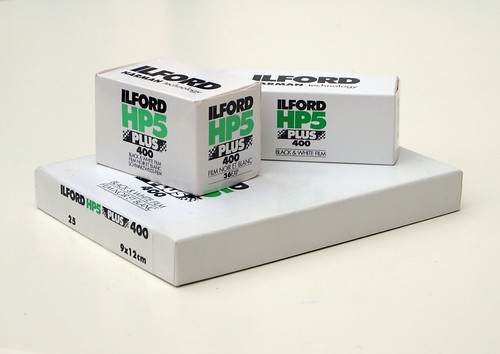 |
| Ilford HP5 Plus in 35mm, medium format and sheet film |
HP5 Plus is Ilford's best selling black and white film. The first Ilford film designated HP (for
Hypersensitive Panchromatic) was introduced in 1935 and had a speed of 160 ISO (by revised, post-1960 ASA standards). By the 1950s the HP emulsion had its speed increased to 400 ISO. Its current iteration, HP5 Plus, remaining at 400 ISO, was introduced in 1989.
HP5 Plus was developed to compete with Kodak Tri-X, the photojournalists' film of choice: in the field of press photography, high-speed, good latitude, 'pushability' and ease of development were all desirable qualities over fineness of grain in the final image. HP5+ is currently available in 35mm, 120, and numerous sheet film sizes.
For many years when choosing a black and white film, HP5 Plus was simply the 'default' film for me. In my
post about Delta 3200, I described how, when I began developing my own films at college, I was frequently taking hand-held shots in low-light conditions, and speed was more important to me than fineness of grain. Using ID11 as a developer, I was able to take advantage of being able to push the film, and rate it up to EI 3200. However, since I've returned to developing my own films and use Rodinal instead of ID11, I've become more discerning about the combination of film and developer, and I've explored a wider range of films than I used as a student. As a consequence I don't shoot HP5 as often in 35mm as the grain can be obtrusive, but this does depend on the subject matter (the images on this post are from 35mm negatives, unless indicated otherwise). Of course, 35mm film tends to stay in a camera longer than medium format, so while I might load a camera for taking low light shots, often the film is used up on other subjects entirely. However, I still use HP5 regularly in medium format, and being a traditional cubic-type emulsion, HP5 does has a particular look (which is difficult to define in words) and a great tonality I really like, especially when combined with a yellow filter for landscape work. By comparison, I've found Ilford's Delta films have a slightly 'harder' look to them (at least the 100 and 400 speed versions), and are more finickety in terms of exposure to get good results. I've only tried a couple of rolls of Kodak Tri-X, which I know lots of photographers love, but I prefer HP5.
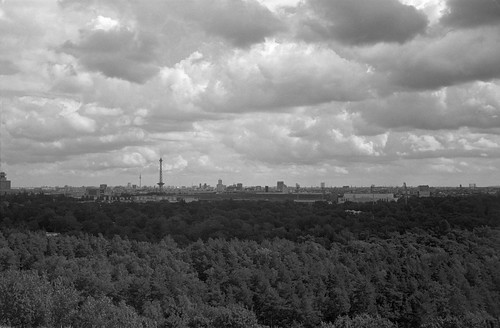 |
| Berlin from the Teufelsberg, HP5 (medium format, 6x9, with yellow filter) developed in Rodinal 1:25 |
Apart from the look of HP5, the main reason to use the film is its versatility: Ilford state it can be used at meter settings from 400 to 3200, and give a range from 250-3200 on their developing chart; I have inadvertently used it as low as 64. Ilford also mention its wide exposure latitude; it's described as
'bullet-proof' by Ag Photographic (the
comparison to other 400 ISO films on Digital Truth appears to confirm this). I've personally found that the film takes overexposure well while retaining highlight detail. For example, a couple of long-exposure night shots from Paris appeared nearly white on the contact sheet compared to other frames on the roll, yet when scanned revealed much more detail than the contact promised.
 |
| Carreau du Temple, Paris, HP5 developed in Rodinal 1:50, 13m45s at 18ºC. |
HP5's versatility does lend it to push processing. The Ilford
fact sheet for HP5 recommends Ilfotec DDX/HC/RT Rapid or Microphen for push processing, none of which I've used. The two developers I have used with HP5 are ID11 when at college, and Rodinal. For the box speed of 400, I prefer the results using Rodinal diluted 1:25; however when rating the film at 1600, I've used a dilution of 1:100, stand developing the film for 2 hours or more. It may seem counter-intuitive, but push processing works best with plenty of light: low-light or night time scenes are often high contrast, with highly localised sources of light, and achieving shadow detail can be a problem.
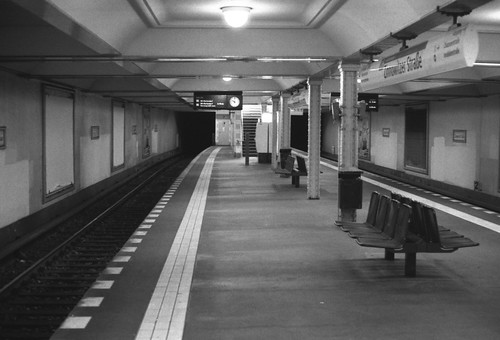 |
| Zinnowitzer Straße, HP5, push processed to EI 800 in Rodinal |
 |
| Shepherd's Lane, HP5 push processed to 1600, stand developed in Rodinal 1:100, 2 hours 20 minutes |
 |
| Liverpool Street Decorative Stonework, HP5 rated at 3200, developed in ID11 stock solution, 18m at 20ºC. |
I rarely pull-process films of any kind, but I have shot HP5 at 64 ISO by accident. I thought my camera was loaded with outdated FP4 and exposed it at half of FP4's normal speed. I only realised my mistake when I took the film out of the camera. To compensate for the accidental over-exposure, I developed it at 100 ISO (the slowest rating on the
Massive Dev Chart; the film could easily take a little more exposure, giving a slightly thicker negative). Incidentally, I shot the film in my
Kodak Retina IIa, and didn't meter it in any way, relying on the
'sunny 16' rule (something I often do with manual cameras, partly out of laziness). Apart from accidents, I have occasionally used HP5 at EI 200 to reduce contrast. This can useful on bright sunny days with deep shadows, in spring or autumn, when the sun can be as bright as summer but the angle of the sun casts longer shadows; this isn't the case with the second image below, but the metal roof of the fire escape and the rendered wall are bright in comparison with the brick wall facing the street, and as such the subject benefits from a lower level of contrast.
 |
| Ceramic studio, HP5, rated 64, developed (as 100 ISO) in Rodinal 1:50 for 9mins at 20ºC. |
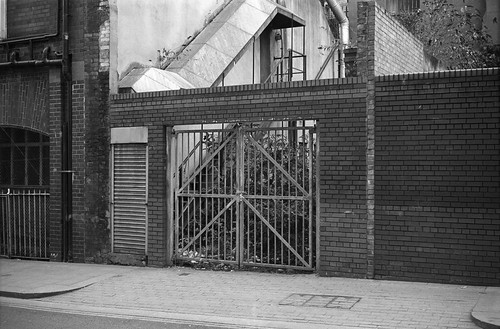 |
| Gate & Buddleia, HP5 (medium format, 6x9) pull processed to 200, developed in Rodinal 1:50 |
Through years of use and experimentation, I've come to appreciate all the qualities of HP5 which were those that appealed to the photojournalists the film was originally developed to cater for, without being aware of this. In film photography there's no one ideal film that covers all subjects, all lighting situations; even with the contraction of the market, there are still many different films available. This is, incidentally, one benefit of film photography: the ability to tailor film, and its development to the effects one wants to achieve. However, in the hypothetical position of only being able to choose one film to have with me for all eventualities, it would be HP5 Plus.
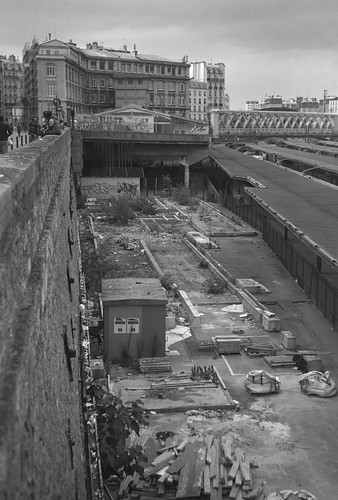 |
| Gare de l'Est, HP5 (medium format), developed in Rodinal 1:25, 8 minutes |
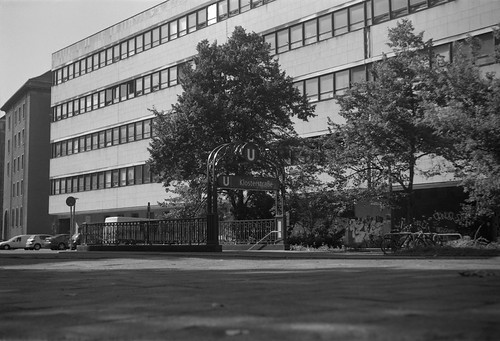 |
| Klosterstraße, HP5 (medium format), developed in Rodinal 1:25, 8 minutes |
 |
| Bocca Dell Verita, HP5 (medium format) developed in Rodinal |
Sources
http://www.ilfordphoto.com/products/product.asp?n=7
http://www.photomemorabilia.co.uk/Ilford/Chronology.html
http://www.photomemorabilia.co.uk/Ilford/Chronology/HP5+_Photopro_Winter1989-90.pdf










